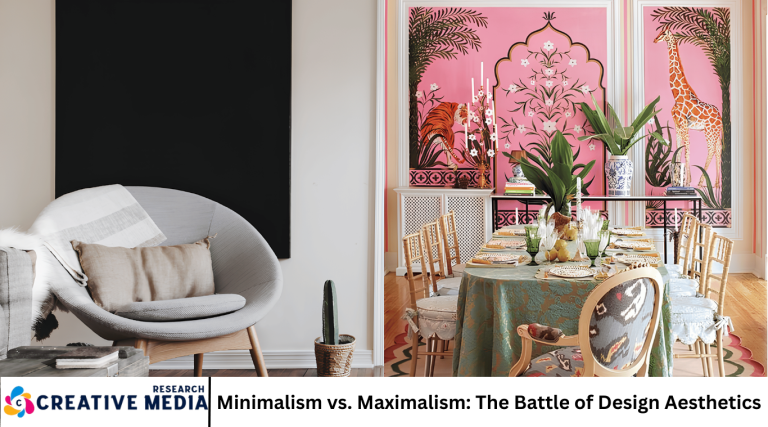Design is an art of communication, and how we visually express ideas greatly impacts perception and experience. Among the many design philosophies, minimalism and maximalism stand out as two distinctly different yet equally powerful aesthetics. Each offers a unique approach to creativity, storytelling, and style, often sparking lively debates among designers, artists, and audiences alike.
This article explores the battle of design aesthetics between minimalism and maximalism—examining their origins, principles, strengths, weaknesses, and practical applications. We will also highlight how these styles influence various design fields like graphic design, interior design, fashion, and digital media. Finally, we’ll answer common questions to help you understand and choose between these two compelling approaches.
What is Minimalism?
Minimalism is a design philosophy centered around simplicity, functionality, and clarity. It strips away the unnecessary to reveal the essence of an idea or object. Originating in the mid-20th century as a reaction against ornate and cluttered art forms, minimalism promotes “less is more.”
Key Principles of Minimalism
- Simplicity: Use of clean lines, limited color palettes, and basic shapes
- Functionality: Every element has a purpose; no decoration for decoration’s sake
- Negative Space: Strategic use of empty space to create balance and focus
- Clarity: Design communicates clearly and efficiently without distractions
Minimalism in Practice
Minimalist design is often seen in:
- Modern architecture (e.g., glass, steel, and open spaces)
- User interfaces with clean, intuitive navigation
- Branding with simple logos and limited colors
- Fashion featuring neutral tones and streamlined silhouettes
Benefits of Minimalism
- Creates a calm, uncluttered experience
- Enhances usability and focus
- Timeless and elegant aesthetic
- Easy to maintain and adapt
What is Maximalism?
Maximalism, on the other hand, embraces abundance, complexity, and richness. It celebrates “more is more” and uses layers of colors, patterns, textures, and forms to create vibrant, expressive designs. Maximalism challenges minimalist ideals by encouraging freedom, boldness, and individual expression.
Key Principles of Maximalism
- Boldness: Use of bright, contrasting colors and dramatic forms
- Eclecticism: Mixing diverse styles, patterns, and cultural influences
- Layering: Multiple elements combined for depth and visual interest
- Expressiveness: Designs convey personality, emotion, and storytelling
Maximalism in Practice
Maximalist design is common in:
- Interior design with rich fabrics, ornate furniture, and decorative details
- Fashion featuring bold prints, embellishments, and vibrant colors
- Graphic design using complex compositions and mixed media
- Art and photography that highlight extravagance and creativity
Benefits of Maximalism
- Evokes strong emotional responses
- Showcases creativity and personality
- Encourages experimentation and breaking norms
- Creates memorable, impactful visuals
Minimalism vs. Maximalism: Key Differences
| Aspect | Minimalism | Maximalism |
|---|---|---|
| Philosophy | Less is more | More is more |
| Visual Style | Clean, simple, restrained | Bold, rich, ornate |
| Color Palette | Neutral or limited | Vibrant, contrasting |
| Use of Space | Lots of negative space | Filled and layered |
| Emotional Impact | Calm, serene | Energetic, expressive |
| Complexity | Low | High |
| Functionality | Prioritized | Sometimes secondary |
When to Use Minimalism
Minimalism works best when clarity, simplicity, and elegance are priorities. It’s ideal for:
- Corporate branding and professional services
- User interfaces requiring easy navigation
- Environments seeking calm and order (e.g., spas, galleries)
- Products focused on functionality and efficiency
When to Use Maximalism
Maximalism shines when you want to make a bold statement, evoke emotions, or celebrate creativity. It’s perfect for:
- Fashion and entertainment industries
- Events and campaigns needing high visual impact
- Personal expression in art and interiors
- Brands targeting younger or adventurous audiences
Blending Minimalism and Maximalism: A New Trend
Increasingly, designers are blending elements of minimalism and maximalism to create balanced and unique aesthetics. This hybrid approach allows for bold expression without overwhelming the viewer, combining simplicity with impactful details.
Examples of Minimalism vs. Maximalism in Design
Minimalism Example: Apple
Apple’s product design and branding exemplify minimalism. Their clean lines, simple icons, and intuitive interfaces focus on user experience and timeless style.
Maximalism Example: Gucci
Gucci’s fashion collections often showcase maximalism—bold prints, vibrant colors, and lavish details create a distinct personality and luxury appeal.
The Cultural Impact of Minimalism and Maximalism
Minimalism aligns with modern values like sustainability, mindfulness, and digital detox. Maximalism resonates with postmodernism’s embrace of diversity, identity, and self-expression.
Frequently Asked Questions
Which design style is better: minimalism or maximalism?
Neither is inherently better. It depends on the project’s goals, audience, and context. Minimalism suits clarity and simplicity; maximalism favors boldness and creativity.
Can minimalism and maximalism be combined?
Yes, many designers blend the two to balance simplicity with impactful details, creating versatile and engaging designs.
What industries favor minimalism?
Tech, corporate, healthcare, and luxury brands often use minimalism for professional and clean aesthetics.
What industries favor maximalism?
Fashion, entertainment, hospitality, and art industries lean toward maximalism for expressive and vibrant visuals.
How does minimalism affect user experience?
Minimalism enhances user experience by reducing clutter, improving navigation, and focusing attention on essential elements.
Is maximalism more expensive to implement?
Often, yes, because it involves more materials, details, and customization. However, it depends on the scale and medium.
How do cultural factors influence these design styles?
Cultural values and trends impact preference. Minimalism often reflects Western modernism, while maximalism aligns with cultures valuing ornamentation and storytelling.
Conclusion
Minimalism and maximalism represent two ends of the design spectrum—one advocating simplicity and the other celebrating abundance. Both styles offer valuable tools for designers to communicate, inspire, and engage. Understanding their principles, applications, and cultural significance helps creators choose the right aesthetic or blend both to achieve their vision.The battle of design aesthetics is not about winning but exploring possibilities and pushing creative boundaries. Whether you lean toward the elegance of minimalism or the vibrancy of maximalism, both have a powerful role in shaping the visual world around us.

